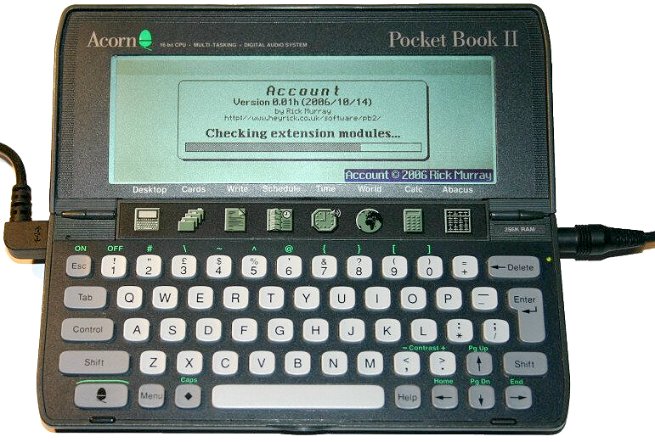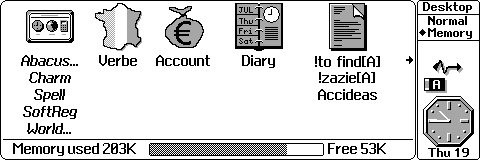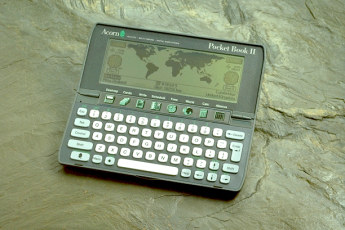Of this 256K, you always lose 8K to the time application. It is the one thing you cannot shut down. In addition, you lose about 80K to the 'Desktop'. This is memory used, basically, by the operating system. The screen buffering? Uses this memory. The task list, settings, etc? Uses this memory.
In addition, the organiser 'fakes' an internal disc for times when there are no SSDs connected. It uses advanced memory management in order for the physical 'size' of this disc to expand and contract as files are added and removed. Think of a totally flexible RAMdisc!

The PocketBook II with serial expansion (on left) and mains power adaptor (on right).
My 'Account' software is in the process of starting up.
On a 14-inch (~36cm) 800×600 display, this is roughly actual size.
The organiser contains a 2Mb ROM. This provides all sorts of useful applications, including a word processor, a schedule, a database, a spreadsheet, and the obligatory calculator. The normal 3A version of the organiser is fitted with a 1Mb ROM. In addition to the 3A functionality, the PocketBook II offers a dictionary/thesaurus as well as a graph plotter.
Perhaps the best way to think of this is to cast your mind back to the mid-'80s when people may have used the GEM desktop on a PC-XT or very early AT. Now replace the CGA or EGA display with a 480x160 three-'colour' display, shrink it down to something that measures 165mm x 85mm x 22mm and weighs a massive 275 grams (and that's including the batteries!).
 |
The memory bar and the clock/info are optional, but I like them as
they provide additional information (is serial link active? is battery low?)
Acorn? Didn't they make the Beeb?
Seriously, much of what BBC BASIC 2 could do was so far ahead of its time it was unreal. How many people who have seen a BBC micro knew that it contained a full 6502 assembler which could handle conditional compilation and cool things like calling a BASIC function to return a value to embed in the assembler program, as well as the ability to jump around a BASIC program to build the assembler. You could write a BASIC program to 'compile' a BASIC program. There was a difference between FUNCTIONS and PROCEDURES, a proper procedure-based program was not only possible, it was simply bad taste to do it any other way.
I'm sorry, I know this has no place in a discussion of the PocketBook II (Psion 3A), but I just get so totally annoyed when people slag off BASIC because the only versions they've seen required a mess of GOTO statements in order to achieve anything remotely useful. This is NOT a fault of the BASIC language, it is a deficiency of that specific version. For what it is worth, OPL supports PROCedures which can take parameters and, if required, return a value. Okay, rant over. ☺
In the nineties, Acorn had switched to the Archimedes. Acorn, always the innovator, didn't find an off-the-shelf solution they liked, so they rolled their own. Yes, for real. The processor, the memory controller, the video display system, everything was custom designed. Because of this, and because of careful hand crafting the operating system (originally Arthur, then RISC OS 2), in assembler, there was a long time when the Archimedes (clocking at 8MHz), was the fastest home computer in the world. It kicked ass. It really did.
This leads us to Psion's tie-in with Acorn - hence the PocketBook II. You see, Acorn know a good thing when they see it, and there is no denying that Psion were very much like Acorn in being well ahead of the game. I was given my PocketBook II by a friend. Surplus to requirements. But, it is eleven years old new and probably the only limitation I can see myself running into is the small on-board memory. Certainly the word processor, schedule, and database are more than useful. Of course, the spreadsheet can also do a lot, but I don't find myself needing to use a spreadsheet very much... er, if ever!
Because of all of the capabilities built into the organiser, Acorn saw the potential to provide it to schoolchildren. After my time so I don't know how well the project worked, but I recall plans to supply every child in England and Wales with one (Scotland is autonomous in these things, perhaps they joined the scheme as well?).
Tragically - and if I've said this once I've said it a million times - Acorn were not good at advertising. It has been said that the entire Archimedes was developed on about the same budget that the Microsoft Corporation spends on toilet paper in a year. It was, as you would expect from Acorn, a technical marvel. A miniature revolution. Only not so many people knew about it! Acorn made a number of bizarre decisions, and anyway now everybody uses PCs. Yeah, including me. God do I miss the friendliness of the RiscPC's operating system, as well as the very friendly companies that actually reply to emails. So many (PC) companies these days have failed to reply to several emails. It is so rude!
Well, Acorn is no longer with us. There was, recently, a computer company trading under the name which was illegal as one of the old Acorn partners (Castle? Oak?) owns the rights. But, effectively, it is just a piece of history.
But their legacy lives on. Castle produces an advanced RISC OS computer called the Iyonix. RISC OS Ltd produces versions of the operating system for the older (RiscPC, etc) generation. The hardware side of Acorn split off into ARM Ltd, which produce versions of the ARM processor and chipset. These days you will find ARM processors inside laser printers, mobile phones, hand-held games consoles (the Gameboy Advance, for example), and all manner of embedded applications... including a more recent partnership with Psion as the series 5 and the Revo use a ARM710T processor clocked at 36MHz.
Advertising pictures from Acorn for the PocketBook (I) and the PocketBook II:


How well was it received?
All these extras are extremely welcome enhancements but to my mind the Pocket Book II‘s major selling point is the graphing application, Plotter, which comes on a plug-in SSD (solid state disc) cartridge. This can handle Cartesian and polar functions, inequality graphs and co-ordinate pairs and effectively turns the machine into a graphical calculator, a piece of equipment which has fast gained favour in A-level and GCSE maths lessons but which has also been shown to have a place in the primary classroom, too. In short, it cuts out all that tedious graph-drawing which, with pencil and paper, is time-consuming and tends to become an end in itself, obscuring the mathematical point of the exercise.Perhaps useful for schoolchildren of that time, but I consider it somewhat ironic that Plotter is perhaps the one application I'm least likely to touch. When I start it, draws a graph cross on the screen and shows a prompt. Okay... now what? :-)
 |
(note - Plotter uses commas as separators and thus expects numbers to be in the form integer-period-fraction regardless of system settings to the contrary... naughty!)
And, as was often usual for that magazine, the information provided is "mostly" correct (as opposed to the competitor magazine that may have been accused once or twice of simply making stuff up!). If we refer to Acorn's own press releases:
Software upgrades for the Pocket Book
These upgrades are not required for Pocket Book II, which includes Plotter and Schedule as standard in the ROM.
Plotter
Plotter is a graph plotting application which increases the capability of the Pocket Book and fulfils the role of a specialist graphical calculator. It has been designed to meet all curriculum needs in Maths and Science for Key Stages 3 and 4 onwards (11-16) and will also meet most of the requirements for A-level. It is supplied on a ROM SSD with a manual. [AHA44 Plotter]
How much did these things cost?
From the official Acorn price list, December 1995:
|
I am not entirely certain about the 1Mb version - other (Acorn) documents refer to a 256Kb model and a 512Kb model (ref: AHB06; AU says it would cost £329.95 (460€ / $592)). I don't understand why the PocketBook (I) would be listed as discontinued, but no mention made of the 512Kb version of the PocketBook II? Also, given the price disparity of the PC-Link+ and the A-Link, I cannot imagine that they are practically the same thing - I have included an entry for what would be the 3link (ref: AHA36), though I do not know the differences between the standard 3link and the PC-Link+... Euro/USdollar prices translated via Sky News Active, 2006/08/19 at 10pm CET, all values rounded to nearest whole. These values are purely figurative and only provided to give some form of value to the sterling prices for readers not familiar with British currency. Due to nearly ten years of changing market conditions, an actual "this is how much it cost" is practically impossible... For example, a couple of thousand (pounds) would have bought a house in the late sixties and bring-home pay was around £500 (700€ / $900) a year. These days a couple of hundred thousand is more the price for a house, and people think they're doing pretty badly to bring in £500 a month - that's part time on minimum wage... VAT is Value Added Tax, at a rate of (usually) 17.5% added to most purchases (though there are other rates - for printed matter, diary products, school clothes, etc etc). In French terms this is equivalent to TVA, and in American terms this is like a Sales Tax. |
What about the PocketBook (I)?
None of my software is designed for the PocketBook (series 3), it is intended for the PocketBook II (3A) - although the little Bricks game uses the emulation mode because the display is bigger and bolder that way (the operating system takes care of rejigging the output to fill the display panel).
I have a real Psion 3A - what then?
Simply replace all references as follows:
| |||||||||||||||||||||||||||||||||||||||
Additionally, I have renamed the Schedule/Agenda file so it says "Diary" under that icon.
I use the 3A emulator, will your stuff still work?
For the bricks game, I have made an emulator-friendly version. It plays pretty poorly, but it does work.
What about other Psions?
Psion Sienna - much like the 3A only with a smaller display (240 x 160). My software probably won't work correctly due to the screen dimensions.
Copyright © 2006 Richard Murray